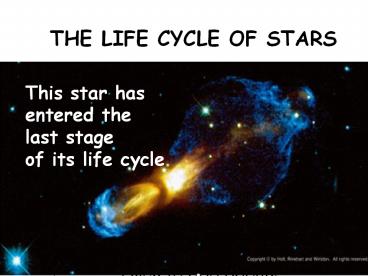THE LIFE CYCLE OF STARS - PowerPoint PPT Presentation
1 / 20
Title:
THE LIFE CYCLE OF STARS
Description:
THE LIFE CYCLE OF STARS This star has entered the last stage of its life cycle The first stage of star formation is NUCLEAR FUSION Gravity pulls clouds ofgas and dust ... – PowerPoint PPT presentation
Number of Views:224
Avg rating:3.0/5.0
Title: THE LIFE CYCLE OF STARS
1
THE LIFE CYCLE OF STARS
This star has entered the last stage of its
life cycle
2
- The first stage of star formation is NUCLEAR
FUSION - Gravity pulls clouds ofgas and dust (nebulae)
together into a sphere as it becomes denser, it
gets hotter and the hydrogen changes to helium.
3
- Stars are classified by
- Size
- Brightness
- Mass
- Color
- Temperature
- Spectrum
- Age
4
TYPES OF STARS
- MAIN SEQUENCE STARS this is the second phase
and the longest phase - Energy is generated in the core as hydrogen atoms
fuse into helium atoms - Stars are about 98 Hydrogen and Helium
- The sun in this stage (10 million yrs. to become
this stage has been shining for 5 billion years
) Earth is 4.6 billion years old
5
GIANTS AND SUPERGIANTS
- Third stage RED GIANT
- RED GIANT A large reddish star late in its life
cycle - a star that expands and cools once it
uses all of its hydrogen - Eventually will shrink
- When shrinks atmosphere grows large and cools
to a red giant or red supergiant - In 5 billion years the sun will become a red
giant
6
- Red giants 10 or more times bigger than the
sun. - Red Supergiants at least 100 times bigger than
the sun.
7
WHITE DWARFS AND RED DWARFS
- WHITE DWARF a small, hot, dim star that is the
leftover center of an old star - No hydrogen left
- Can shine for billions of years before they cool
completely - RED DWARF low-mass stars
- Oldest stars in the universe
8
BLUE STARS
- BLUE STARS very massive blue stars are not in
the main sequence very long. - They quickly use up the hydrogen in their cores
- Expand and turn into giants or supergiants
9
SUPERNOVAS
- A main sequence star with a mass of more than
about 10 Suns experiences a spectacular end. - It swells into a red supergiant with cooling,
expanding outer layers. - Eventually its core collapses, causing a huge
explosion known as a supernova
10
- A gigantic explosion in which a massive star
collapses and throws its outer layers into space
11
NEUTRON STARS and PULSARS
- NEUTRON STAR a star that has collapsed under
gravity to the point that the electrons and
protons have smashed together to form neutrons - If the core of a supernova has relatively low
mass, the core will be crushed into a tiny, super
dense neutron star - PULSAR a spinning neutron star
12
BLACK HOLE
- A volume of space in which gravity is SO GREAT
that nothing can escape, not even light, although
objects can fall in - If the core of a supernova has a mass of more
than about two Suns, its own gravity will squash
it further, into a black hole.
13
HR Diagram (page 592 593)Shows the
relationship between a stars surface temperature
and absolute magnitude.
14
Hertzsprung-Russell Diagram
- The temperature is given along the bottom of the
diagram.
15
Hertzsprung-Russell Diagram
- The absolute magnitude (brightness) is given
along the left side.
16
Hertzsprung-Russell Diagram
- The Hot (blue) stars are located on the LEFT
- The Cool (red) stars are located on the RIGHT.
17
Hertzsprung-Russell Diagram
- The BRIGHT stars are at the TOP.
- The DIM stars are at the BOTTOM.
18
(No Transcript)
19
(No Transcript)
20
- The DIAGONAL pattern where most stars lie is the
MAIN SEQUENCE. - The SUN is located in the middle of the diagram.
- Average stars like the sun become giants or
supergiants (Right) and then down to the left to
become white dwarfs.































